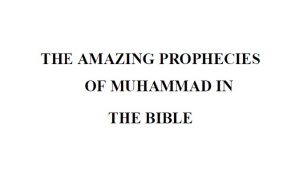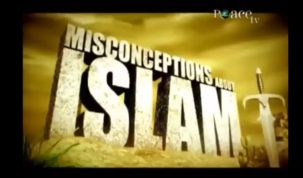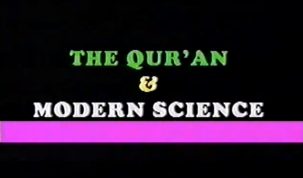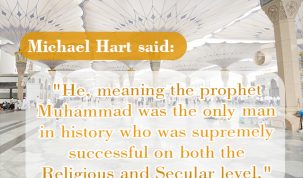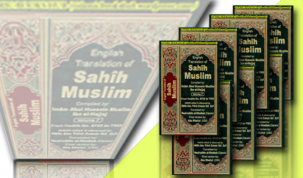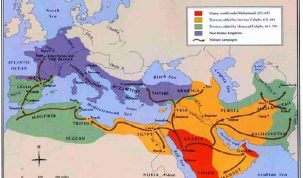Question- How can any Muslim believe the words and actions of Mohammad are true when these stories weren’t even written until 250 years after Mohammad died? It’s impossible they are in any way reliable.
The Answer
The first of the criticisms which are now commonly being directed against the Hadith is that they were not collected in the time of the Prophet or of the Khulafa’ al-Rashidun, and that during the period between the utterance or occurrence of their contents and their being recorded in writing there was every chance of their being materially altered. Some have even gone so far as to say that they were not recorded because they were unreliable. That in the earlier stages they were not fully recorded in writing, is true, though it is not true that they were not recorded at all even as regards the Prophet’s lifetime, for there is good evidence to show that `Abdullah b. `Amr b. al-`As for one, used to write down what he heard from his Master. Other Companions too put their collections of Hadith into writing later in life, particularly Abu Hurayrah and `Abdullah b. `Abbas, two very important sources of Hadith. But in general it can be said that Hadiths were only partially and privately recorded in writing in the early stages.
The reasons for this are quite clear and there is nothing mysterious about them. The Arabs’ antipathy to writing in this period is well-known, very few of were literate. Huge stores of knowledge of genealogy and poetry preserved in their prodigious memories; some people being able to recite a hundred thousand verses. There were no books in currency among them; even during the Prophet’s lifetime the Qur’an did not circulate in book form. The fact that the Prophet’s sayings, legal decisions and deeds, were not generally written down is therefore not surprising in the least. There is also evidence that the Prophet disapproved of the general writing of Hadith in his lifetime for fear that they would become mixed up with the Qur’an, which had not yet been fully revealed, and with which the Muslims had yet to become completely familiar. But this is not to say that he disapproved of memorising of, or acting upon Hadith; on the contrary, he insisted on it. The more learned of the Companions, including the Khulafa’ al-Rdshidun, spent their time in absorbing thoroughly the explanations, applications, and developments of the Qur’an by the Prophet in addition to their study of the Qur’an itself. When the Prophet had passed away from this world and the age of the Caliphs came, after some deliberation they also came to the conclusion that the written recording of Hadiths and publishing them in a book form was inexpedient at this stage, for the same reasons as in the Prophet’s lifetime, that the Word of Allah must be learnt and studied and thoroughly absorbed first, while its practical application by the Prophet can be handed down by word of mouth and by personal example. But if we look at the life and the decisions of the Khulafa’ al-Rashidun, we find that in every case where any matter had not been dealt with explicitly by the Qur’an, they considered it obligatory to discover what was the practice of the Prophet in this situation and made their decisions according to their findings. To contravene the practice of the Prophet on any vital matter was in their eyes equivalent to contravening Islam itself.
The whole of the history of this period shows this valuation of the Prophet’s practice, and on this point there is complete unanimity. It is a grave mis-statement to say that `Umar al-Khattab was against the relating of Traditions; he was only against collecting them into book form, not that they should not be learnt and known. He was certainly strict as regards accuracy of reporting and always demanded a supporting witness if any Companion recounted something of the Messenger of Allah; when that witness was forthcoming he accepted the Tradition with no further hesitation. In those cases which came up before him he continually had recourse to his own knowledge of the Prophet’s rulings, and if he himself did not have this knowledge he appealed to the other Companions; on receiving the required information and after satisfying himself regarding its accuracy, he immediately acted upon it. Indeed, the fact that Hadiths were completely recorded in writing during the lifetime of the Companions was no drawback; they themselves were living models of his practice and treasure-houses of his sayings. They spread over the huge areas which now constituted the Islamic empire, to Kufah and Basrah in Iraq, to Syria, Palestine, Egypt and Khurasan. Here they were surrounded by eager pupils both Arab and non-Arab, thirsting to hear about their revered Prophet from those who had seen and lived with him. Some of these pupils, who are known as the Followers of the Companions (Tdbi `un), became renowned all over the Islamic world for their learning in the Qur’an and the Sunnah, for their correct reporting and understanding of Hadith, and for their piety and purity of life. Such were Hasan Basri, the associate of the companions `Imran b. Husayn and Anas b. Malik in Basrah; Alqama and Aswad, the repositories of the vast learning of `Abdullah b. Mas’jid in Kufah, who were also the pupils of `Umar and `A’ishah; Said b. Musaiyib, the pupil of Abu Hurayrah and Taus, Mujahid, `Ata’ b. AM Rabah and others; Nafi`, the pupil of `A’ishah, and many others whose honesty and trustworthiness are unquestioned. Here it is important to note that `A’ishah and Abu Hurayrah lived up to between 50 and 60 A.H, `Abdullah b. `Abbas and `Abdullah b. `Umar to around 70 A.H., Abu Said Khudri to between 70 and 80 A.H. and Anas b. Malik to 90 A.H. This is to say that in the second half of the first century of the Hijrah it was still possible to hear a great store of Hadith from those who had seen or heard them directly from the Messenger of Allah himself.
Nearly all the famous Tabi `un we have mentioned just now, lived up to dates between 90 and 120 A.H., which means up to this time the collections of Hadith related by these perfectly reliable reporters were available to all who wished to take them. Before the first quarter of the second century (100-125 A.H.) collections in book form were still not current, and although many Tabi`un had their private written collections, the main basis of teaching was verbal, as was the fashion during this era when knowledge even if written was always committed to memory. It was at this time that the first large-scale collections in book form began to be made, those by Ibn Jurayj, Malik, Sufyan Thawri, Ma’mar b. Rashid and others, all pupils of the Tabi`un. The idea that much time elapsed between the original hearing and final recording in book form of Hadith as would make them unreliable is found to be completely unfounded when their history as given above is attentively considered, particularly with regard to these early collections, almost all the contents of which found their way into the later collections of al-Bukhari etc., a century later. But the principle is also established that those Hadiths recounted by the well-known and reliable Tabi`un whether collected into book form or not were available from the recounters themselves up to the first quarter of the second century of the Hijrah, and it only requires two or three successive trustworthy scholars of Hadith to convey them to al-Bukhari and his contemporaries. It is also necessary to mention that between the earliest published compilations and al-Bukhari’s time there were other large classified collections of great importance such as that of `Abdur Razaq (died shortly after 200 A.H.), the pupil of Ibn Jurayj, Sufyan Thawri, Ma’mar b. Rashid and Malik, the earlier collectors. The question arised as to what were these unreliable, wrong or concocted Hadith of which so much fuss is being made by ill-informed critics today?
It is not true to state that untrustworthy traditions regarding the Messenger of Allah existed to any noteworthy extent during the main portion of the era of the Khulafa’ al-Rashidun. It was only when the Schismatics began to appear such as the Kharijis, and the dynastic clashes of the Banu Umayyah, Banu `Abbas and Band Hashim convulsed the Ummah, and particularly after the martyrdom of Imam Husayn and his family at Karbala’, that some partisans had recourse to distorting or inventing Hadith to justify their claims. But it was never the real scholars of traditions who related these incorrect reports, nor had they any purpose in doing so; unreliable Traditions were purveyed by unreliable people, the partisans, popular preachers, story-tellers and so on, and have not escaped the eagle eyes of the very critical Muhaddithun. The solid body of recognised Hadith which forms the basis of Muslim Law can be found in Malik as well as in the decisions of Abu Hanifah and the later Imams. If there are differences of opinion on any important point it is almost always where that difference already existed among the companions. What is remarkable about Muslim law based on the Qur’an, and Sunnah as presented by Abu Hanifah and Malik, for instance, is not the differences in detail but the extraordinary agreement in its main structure, which proves that there was an agreed corpus of Sunnah which was common to both schools of thought. It is a common fallacy to speak of the accepted books of traditions such as al Bukhari, Muslim, al-Tirmidhi, etc., as if they themselves constitute the source of Islamic Fiqh. They are certainly adduced as authorities in later judicial controversy, but it is often forgotten that the whole fabric of Fiqh was erected before these traditionists were even born. Abu Hanifah himself was born in 80 A.H. when some of the other Companions of the Prophet were still alive, and he was the pupil of some of the famous Tabi`un we have mentioned above, particularly `Ata’ b. Abi Rabah in Makkah. The body of traditions used by Abu Hanifah and Malik were fresh from the Tabi`un and unsullied by partisan politics and imaginative interpolations, which in any case affected traditions treating with law very little. These traditions are present in the later collections, but were used by Abu Hanifah one hundred years earlier.
The statement reported by the biographers of Imam al-Bukhari that he selected 7,000 Hadiths out of 600,000 is being put to much use by the detractors of Hadith to attempt to show that the majority are unreliable. This statement was made to extol his industry and discrimination, but from the point of view of the history of Hadith it is necessary to go more deeply into the matter and avoid rash conclusions which do not conform to reality. In citing this bare statement, the impression is given that in al-Bukhari’s time there was a vast, unclassified mass of every kind of tradition, true and false, floating all over the then Islamic empire, and that he suddenly appeared on the scene, separated the true from the false, and was only able to find 7,000 out of 600,000. The real facts are nothing resembling this at all. Criticism and scrutiny of Hadith was being done from the very beginning, even in the time of the Companions and their Followers, and there had always been a central core of unquestionable true Hadith with the earnest, sincere and pious scholars. For instance, the comments of Muhammad b. Hasan, the renowned pupil of Abu Hanifah, on Malik’s book of Hadith, the Muwatta’, show that out of more than a thousand traditions of the Messenger of Allah and the Companions quoted by Malik, Abu Hanifah only differed with about eighty and even then not regarding their authenticity, but preferring a different ruling. The mischief of fabricating or distorting Hadith was begun, during the time of the political dissension between the Banu Hashim and the Umayyads, and particularly after the massacre of Karbala’, when unprecedented passions were roused. But these unreliable traditions circulated among the leading partisans of these two parties and were used to prospective supporters; the really learned were well aware of this and such dishonest tampering with the true Sunnah was clearly denounced by them, and the relaters of such traditions singled out and condemned.
A study of the comments of traditionists on such fabricators and the rejection of their claims to credibility show this plainly, for instance, al-Sha’bi, one of the leading Tabi`un in knowledge of tradition and law, roundly condemns various people who related much partisan reports attributing them wrongly to `Ali. This kind of fabrication had currency among the ignorant and those who had special
interest, not among the scholars.
A second breeding-ground for incorrect and exaggerated traditions were the public preachers and story-tellers, who are prone to this weakness to the present day. The books of the biographies of the reporters of traditions are full of condemnations of people of this type, and their effusions, though gaining currency among the unlettered, were never accepted by the learned. Apart from these two main sources of falsification, there were other unreliable Hadiths which were due to mere human weakness, such as forgetting, mixing-up, exaggeration, ascribing statements of the Companions to the Prophet himself and so on. The whole science of the traditionists was brought to bear on the elimination of such weak reports, and by an amazingly thorough system of analysis and comparison and minute checking, these defects have been brought to light and carefully classified.
The immense research which has gone into the study of Hadith cannot be imagined by simply reading the bare translation of one of the well-known compilations. To know something of what the Muslim traditionists have achieved, one has to go through such comparative studies of Hadith such as `Asqalani’s commentary on al Bukhari, where all the ramifications of the variants of a particular Hadith are traced meticulously. After making such a study the only honest conclusion one can reach is that it is difficult if not impossible to arrive at anything but the same conclusions as these great Muslim
religious scholars. With regard to the statement regarding al Bukhari’s selection of Hadith, it is also necessary to understand that in the language of traditionists, all the variants of a single Hadith are counted as a separate Hadith, or an identical Hadith related by two or more different persons. For instance, the famous Hadith reported by `Umar, “actions are judged by intentions,” is related from 700 different authorities. In the terminology of the traditionists, these are counted as 700 Hadiths. Thus the large number of Hadith mentioned are not actually all different, but contain many slight variations of a single Hadith.
In sum, this statement regarding al-Bukhari’s discrimination only amounts to say that he took the trouble to study the whole of the Hadiths, both reliable and unreliable, which existed written or unwritten in his day. But it should not be imagined that he was the first to determine the true from the false; a generally agreed body of good and fair traditions was already in existence with the earlier traditionists. Al-Bukhari added his own unparalleled acumen to make a final examination and compiled a definitive selection of those Hadiths which possessed the very best authority. Those who lightly challenge the authority of such compilations should be well aware of what they are doing; it requires a person of exceptional industry and intelligence even to reach to the level of a pupil of these great Muhaddithun. To surpass them would require something more than the superficial and biased minds of today, which have not shown themselves capable of any constructive work in the religious field up to the present.
Sheikh Salih Al Munajjid says…
Question:
Some people reject the Sunnah on the basis that there are many weak and fabricated ahaadeeth and that the fabrications of many liars weaken the Sunnah and make it such that it cannot be trusted. What is your opinion about this claim?
Answer:
Praise be to Allaah.
This is the view of some heretics and misguided people, both in the past and nowadays. In modern times, those who expressed this view include Saalih Abu Bakr in his book al-Adwaa’ al-Qur’aaniyyah; Husayn Ahmad Ameen in Daleel al-Muslim al-Hazeen; Ahmad Ameen in Fajr al-Islam; ‘Abd-Allaah al-Na’eem in Nahwa Tatweer al-Tashree’ al-Islaami; Sa’eed al-‘Ashmaawi in Haqqeeqat al-Hijaab; Saalih al-Wardaani in his misleading book Rihlati min al-Sunnah ila al-Shee’ah; ‘Abd al-Jawaad Yaaseen in al-Sultah fi’l-Islam; Nasr Abu Zayd in Imaam al-Shaafa’i; Zakariya ‘Abbaas Dawood in Ta’ammulaat fi’l-Hadeeth; Hawlat Nahr in Diraasaat Muhammadiyyah; Maurice Bucaille in Diraasat al-Kutub al-Muqaddisah; Murtada al-‘Askar in Khamsoon wa Mi’ah Sahaabi Mukhtalaq; Dr. Mustafa Mahmood in Maqaalaat ‘an al-Shafaa’ah.
We say: it is true that there were fabricators and liars who made up words and attributed them to the Messenger of Allaah (peace and blessings of Allaah be upon him), but the matter is not quite so simple as imagined by those doubters who also spread doubts among others. They are unaware of the facts about how the Muslims took care of the Sunnah. Alongside the fabricators, there were great numbers of narrators who were trustworthy and highly skilled, and a large number of scholars who surrounded the hadeeths of the Messenger of Allaah (peace and blessings of Allaah be upon him) with a strong barrier which was difficult for the liars to penetrate. By means of their vast knowledge and deep insight, these muhaddithoon (scholars of hadeeth) were able to spot the liars and understand their intentions and motives, and they were able to detect everything that was falsely attributed to the Messenger of Allaah (peace and blessings of Allaah be upon him). These fabricators were not given free rein to do as they wished with the ahaadeeth of the Prophet (peace and blessings of Allaah be upon him), and they were given no room to penetrate the ranks of trustworthy narrators of ahaadeeth without being detected.
Who else exposed the lies of these kaafirs, heretics and extreme innovators?
Who were the ones who gave us the definition of what is fabricated, the reasons for fabrication, different types of fabrications and the signs by which a fabricated report may be recognized? Who wrote so many books on this issue?
They are the guardians of Islam, the vicegerents and troops of Allaah on His earth. They are the brilliant scholars of whom Haaroon al-Rasheed spoke when he arrested a heretic and ordered that he be executed. The heretic said, “Why are you executing me?” Haaroon al-Rasheed said, “To rid the people of you.” The heretic said: “O Ameer al-Mu’mineen, what will you do about the thousand ahaadeeth – according to one report, four thousand ahaadeeth – which I have fabricated and spread among you, in which I made what is halaal haraam and what is haraam halaal, of which the Prophet uttered not one letter?” Haaroon al-Rasheed said to him: “What will you do, O enemy of Allaah, about Abu Ishaaq al-Fazaari and ‘Abd-Allaah ibn al-Mubaarak? They will go through them and sift them letter by letter.” (Tadhkirat al-Huffaaz by al-Dhahabi, 1/273; Taareekh al-Khulafaa’ by al-Suyooti, p. 174).
Professor Muhammad Asad said: “The existence of fabricated ahaadeeth cannot be taken to prove that the entire system of hadeeth is not to be trusted, because these fabricated ahaadeeth never deceived the muhadditheen as some European critics claimed, oversimplifying the matter, and as was echoed by some who claim to be Muslims.” (al-Islam ‘ala Muftaraq al-Tareeq, p. 96)
We will end this discussion by quoting what was said by Imaam Ibn al-Qayyim al-Jawziyyah: Imaam Abu’l-Muzaffar al-Sam’aani said: “If they say: there are too many reports in the hands of the people and they have become confused, we say: no one is confused except those who are ignorant. Those who have knowledge of them (the reports) check them as stringently as those who deal with money check dirhams and dinars. So they single out (and discard) the false reports and keep the good reports. If there happens to be a narrator who made a mistake, this will not go unnoticed by the brilliant scholars of hadeeth. These scholars listed the mistakes made in both the isnaad (chain of narrators) and matn (texts) of reports; so you can see that for each narrator they made a list of the mistakes that he had made and the letters that he had mispronounced. If the mistakes of the narrators – in both the isnaad and the matn – did not go unchecked, then how could the fabricated ahaadeeth manufactured by the heretics have slipped past those brilliant scholars? How could people have narrated ahaadeeth from heretics without the scholars noticing? That is the view of some heretics, but no one would say such a thing except one who is ignorant, misguided, an innovator and a liar who wants to undermine the saheeh ahaadeeth and true reports of the Prophet (peace and blessings of Allaah be upon him) and confuse ignorant people by means of this lie. There is no evidence for rejecting the reports of the Messenger of Allaah (peace and blessings of Allaah be upon him) that is weaker or more impossible than this. The one who voices this view deserves to be silenced and expelled from the Muslim lands. (Mukhtasar al-Sawaaiq al-Mursalah, 2/561 ,Al-Bayaan magazine, issue #153, p. 26)






